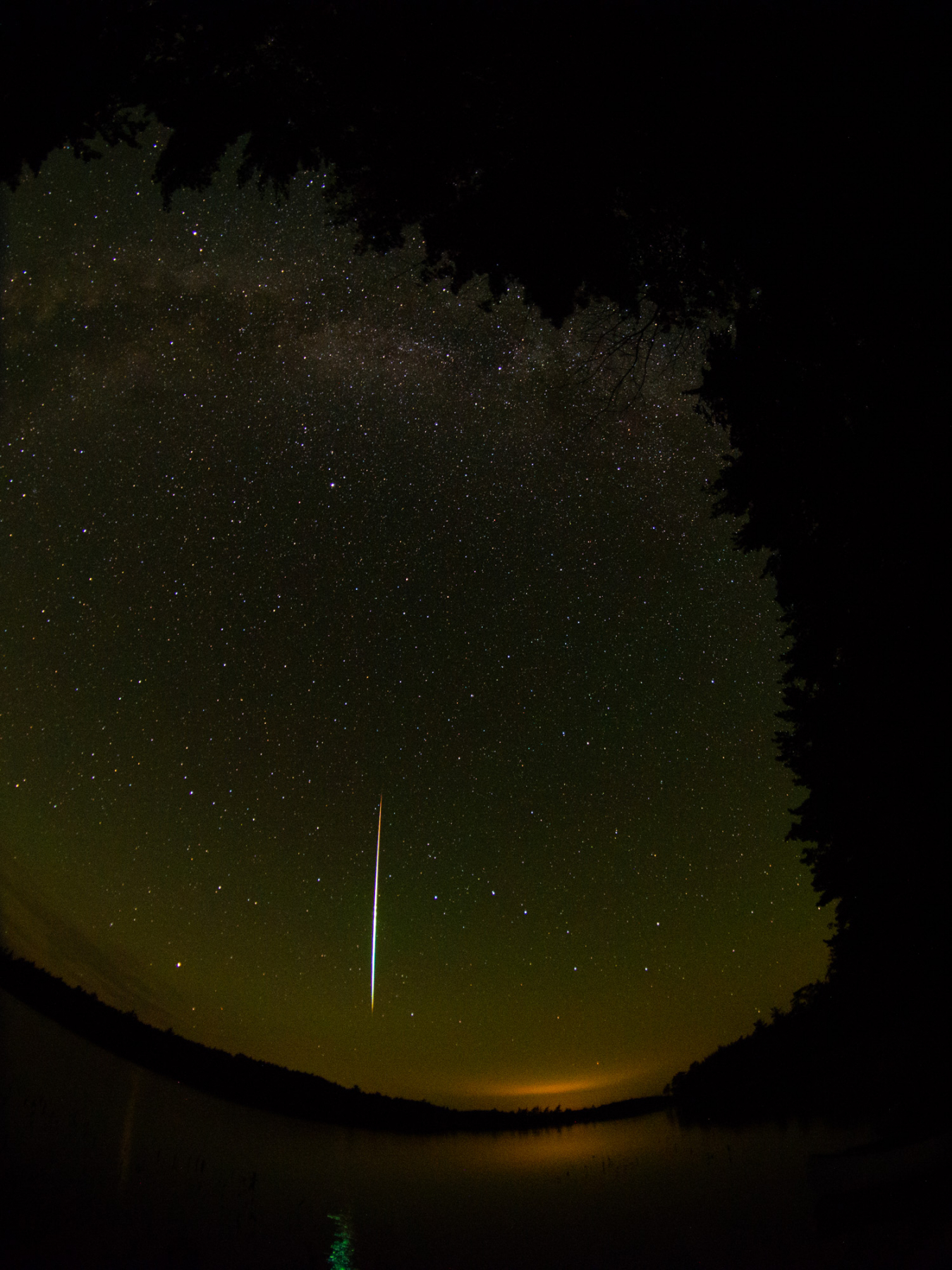 Jerry Black captured this impressive fireball from Maitland Bridge, Nova Scotia, Canada, on 7 October 2021 at 20:42 AST (23:42 UT). In addition to Nova Scotia, this fireball was seen from Prince Edward Island, New Brunswick, and the New England portion of the USA. More information on this fireball is available at: https://fireball.amsmeteors.org/members/imo_view/event/2021/6384 ©Jerry Black
Jerry Black captured this impressive fireball from Maitland Bridge, Nova Scotia, Canada, on 7 October 2021 at 20:42 AST (23:42 UT). In addition to Nova Scotia, this fireball was seen from Prince Edward Island, New Brunswick, and the New England portion of the USA. More information on this fireball is available at: https://fireball.amsmeteors.org/members/imo_view/event/2021/6384 ©Jerry BlackJanuary is best known for the Quadrantids, which have the potential of being the best shower of the year. Unfortunately, this shower is short lived and occurs during some of the worst weather in the northern hemisphere. Due to the high northern declination (celestial latitude) and short summer nights, little of this activity can be seen south of the equator. There are many very minor showers active throughout the month. Unfortunately, most of these produce less than 1 shower member per hour and do not add much to the overall activity total. Activity gets interesting as seen from the southern hemisphere as ill-defined radiants in Vela, Carina, and Crux become active this month. This activity occurs during the entire first quarter of the year and moves eastward into Centaurus in February and ends in March with activity in Norma and Lupus. Sporadic rates are generally similar in both hemispheres this month. Sporadic rates are falling though for observers in the northern hemisphere and rising as seen from the southern hemisphere.
During this period, the moon reaches its new phase on Sunday January 2nd. At that time the moon lies near the sun and is invisible at night. As the week progresses the waxing crescent moon will enter the evening sky but will set long before the more active morning hour arrive. The estimated total hourly meteor rates for evening observers this week is near 3 as seen from mid-northern latitudes (45N) and 2 as seen from tropical southern locations (25S). For morning observers, the estimated total hourly rates should be near 18 as seen from mid-northern latitudes (45N) and 11 as seen from tropical southern locations (25S). The actual rates will also depend on factors such as personal light and motion perception, local weather conditions, alertness, and experience in watching meteor activity. Note that the hourly rates listed below are estimates as viewed from dark sky sites away from urban light sources. Observers viewing from urban areas will see less activity as only the brighter meteors will be visible from such locations.
The radiant (the area of the sky where meteors appear to shoot from) positions and rates listed below are exact for Saturday night/Sunday morning January 1/2. These positions do not change greatly day to day so the listed coordinates may be used during this entire period. Most star atlases (available at science stores and planetariums) will provide maps with grid lines of the celestial coordinates so that you may find out exactly where these positions are located in the sky. I have also included charts of the sky that display the radiant positions for evening, midnight, and morning. The center of each chart is the sky directly overhead at the appropriate hour. These charts are oriented for facing south but can be used for any direction by rotating the charts to the desired direction. A planisphere or computer planetarium program is also useful in showing the sky at any time of night on any date of the year. Activity from each radiant is best seen when it is positioned highest in the sky, either due north or south along the meridian, depending on your latitude. It must be remembered that meteor activity is rarely seen at the radiant position. Rather they shoot outwards from the radiant, so it is best to center your field of view so that the radiant lies at the edge and not the center. Viewing there will allow you to easily trace the path of each meteor back to the radiant (if it is a shower member) or in another direction if it is sporadic. Meteor activity is not seen from radiants that are located far below the horizon. The positions below are listed in a west to east manner in order of right ascension (celestial longitude). The positions listed first are located further west therefore are accessible earlier in the night while those listed further down the list rise later in the night.
These sources of meteoric activity are expected to be active this week.
Now that the activity from particles produced by comet 2P/Encke have ceased encountering the Earth, the Taurid showers for 2021 are over and we resume reporting activity from the Anthelion (ANT) radiant. This is not a true radiant but rather activity caused by the Earth’s motion through space. As the Earth revolves around the sun it encounters particles orbiting in a pro-grade motion that are approaching their perihelion point. They all appear to be radiating from an area near the opposition point of the sun, hence the name Anthelion. These were once recorded as separate showers throughout the year, but it is now suggested to bin them into a category separate from true showers and sporadics. This radiant is a very large oval some thirty degrees wide by fifteen degrees high. Activity from this radiant can appear from more than one constellation. The position listed here is for the center of the radiant which is currently located at 07:32 (113) +22. This position lies in eastern Gemini, 7 degrees southwest of the 1st magnitude star known as Pollux (beta Geminorum). This radiant is best placed near 01:00 local standard time (LST) when it lies on the meridian and is highest in the sky. Rates at this time should be near 3 per hour as seen from the northern hemisphere and 2 per hour as seen from south of the equator. With an entry velocity of 30 km/sec., the average Anthelion meteor would be of slow velocity.
The December Leonis Minorids (DLM) is a shower of long duration active from December 1st all the way through February 10th. Maximum occurred near December 19th when rates may reach 3 an hour. During this period, I would expect hourly rates of 2 from a radiant located at 11:35 (174) +25. This position lies in northern Leo, 6 degrees northeast of the 3rd magnitude star known as Zosma (delta Leonis). These meteors are best seen near 0400 LST when the radiant lies highest above the horizon. At 63 km/sec. the December Leonis Minorids produce mostly swift meteors. These meteors are most commonly known as the Comae Berenicids.
The Quadrantids (QUA) are active from December 26th through January 16th. Maximum occurs on January 3rd near 20:40 Universal Time. The radiant is currently located at 15:16 (229) +50. This position lies in northern Bootes , roughly between 3rd magnitude Edasich (iota Draconis) and Nekkar (beta Boötis). 2nd magnitude Alkaid (eta Ursae Majoris), the bright star at the end of the Big Dipper’s handle, lies 15 degrees to the west. These meteors are best seen during the last hour before dawn when the radiant lies highest above the horizon in a dark sky. At 40 km/sec. the Quadrantids produce meteors of moderate velocity. These meteors are visible from the southern tropics but not seen from the deep southern hemisphere.
As seen from the mid-northern hemisphere (45N) one would expect to see approximately 8 sporadic meteors per hour during the last hour before dawn as seen from rural observing sites. Evening rates would be near 2 per hour. As seen from the tropical southern latitudes (25S), morning rates would be near 7 per hour as seen from rural observing sites and 2 per hour during the evening hours. Locations between these two extremes would see activity between the listed figures. Morning rates are reduced by moonlight during this period.
| SHOWER | DATE OF MAXIMUM ACTIVITY | CELESTIAL POSITION | ENTRY VELOCITY | CULMINATION | HOURLY RATE | CLASS |
| RA (RA in Deg.) DEC | Km/Sec | Local Standard Time | North-South | |||
| Anthelions (ANT) | — | 07:32 (113) +21 | 30 | 01:00 | 3 – 2 | II |
| December Leonis Minorids (DLM) | Dec 19 | 11:32 (173) +24 | 64 | 05:00 | 2 – 1 | II |
| Quadrantids (QUA) | Jan 03 | 15:16 (229) +50 | 41 | 08:00 | 3 – <1 | I |


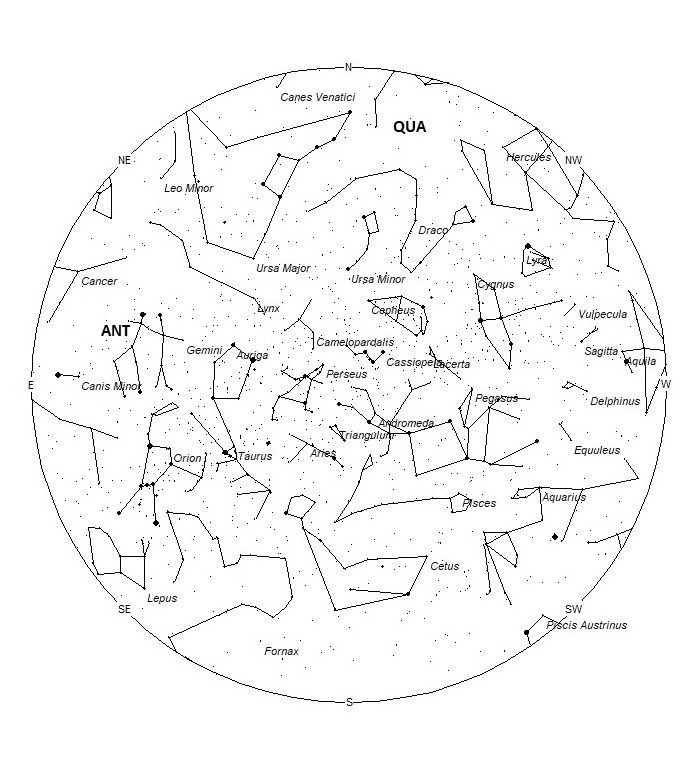
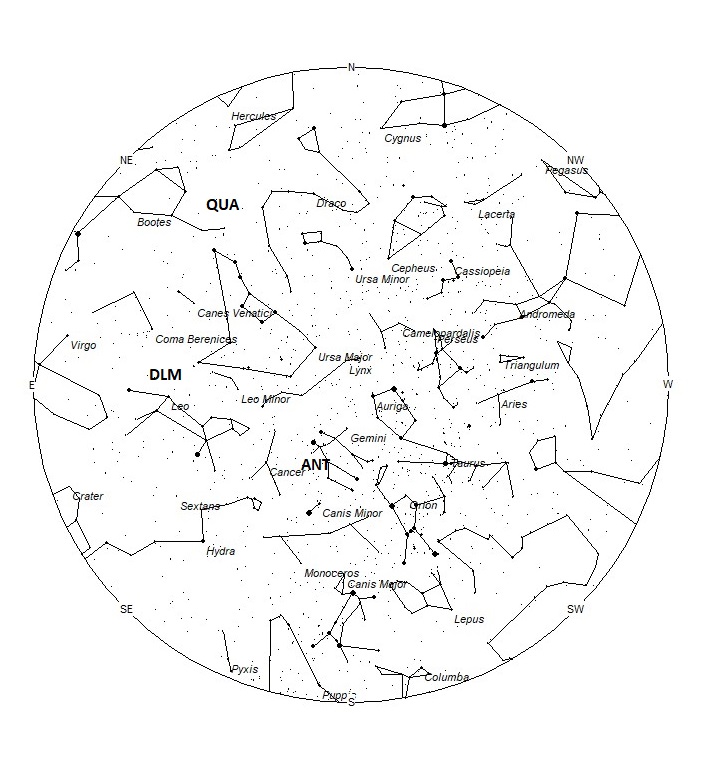
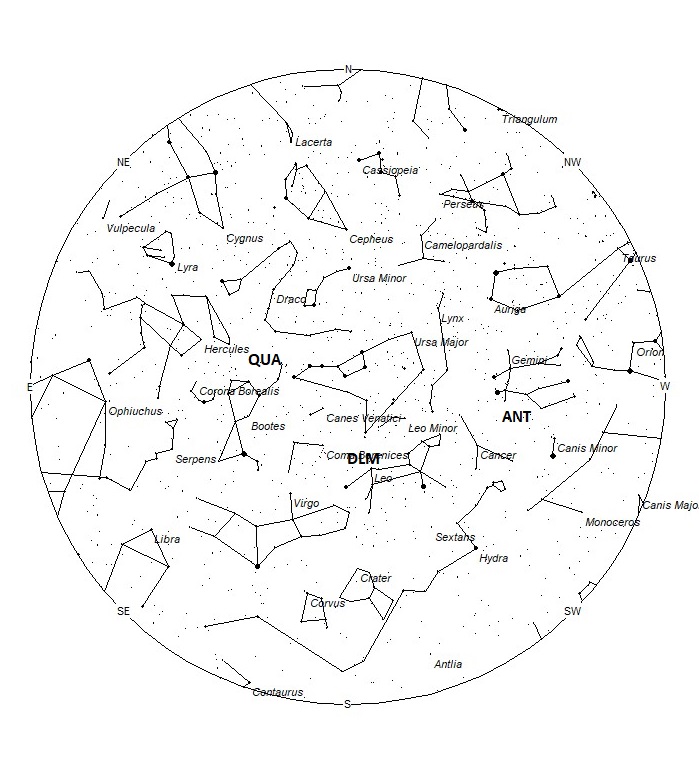

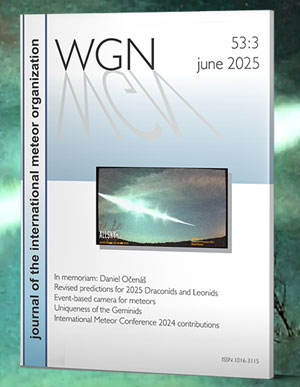
 You saw something bright and fast? Like a huge shooting star? Report it: it may be a fireball.
You saw something bright and fast? Like a huge shooting star? Report it: it may be a fireball.  You counted meteors last night? Share your results with us!
You counted meteors last night? Share your results with us!  You took a photo of a meteor or fireball? You have a screenshot of your cam? Share it with us!
You took a photo of a meteor or fireball? You have a screenshot of your cam? Share it with us!  You caught a meteor or fireball on video? Share your video with us!
You caught a meteor or fireball on video? Share your video with us!
One comment
Hi Robert
My name is Mike and I live in Salix, Pennsylvania. I do a fair amount of meteor observing, and I visit your site weekly. Love it by the way. I was outside this morning from about 3 AM to 5:30 AM to view the Quads. I was even able to catch a few DLM’s and also 2 Zeta Aurigids. The reason why I am writing is I thought I should let someone know that the best and most unexpected meteor I saw this morning at about 4AM was a mag -4 Gamma Ursae Minorid! It was a great site as it glided slowly alongside the handle of the big dipper before it broke up. I know that most sites say that the shower doesn’t kick off until around January 10, so I thought I would let someone know what I saw in case there are any other reports of the shower before that date.
Keep up the great work.
Thanks for your time, I appreciate it.
Mike